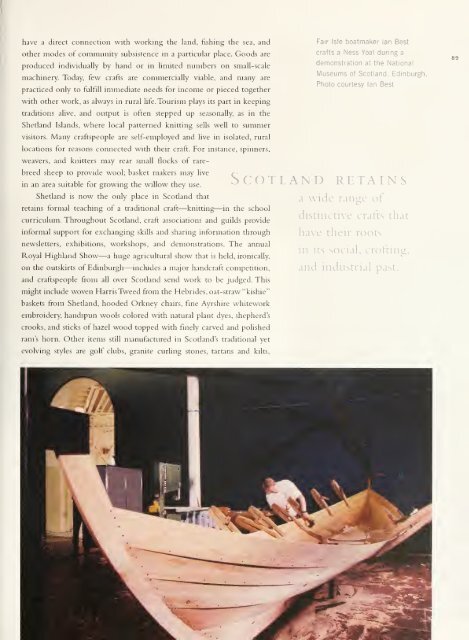SCOTLAND - Smithsonian Digital Repository - Smithsonian Institution
SCOTLAND - Smithsonian Digital Repository - Smithsonian Institution
SCOTLAND - Smithsonian Digital Repository - Smithsonian Institution
Create successful ePaper yourself
Turn your PDF publications into a flip-book with our unique Google optimized e-Paper software.
have a direct connection with working the land, fishing the sea, and<br />
other modes of community subsistence in a particular place. Goods are<br />
produced individually by hand or in limited numbers on small-scale<br />
machinery. Today, few crafts are commercially viable, and many are<br />
practiced only to fulfill immediate needs for income or pieced together<br />
with other work, as always in rural life. Tourism plays its part in keeping<br />
Fair Isle boatmaker Ian Best<br />
crafts a Ness Yoal during a<br />
demonstration at the National<br />
Museums of Scotland, Edinburgh.<br />
Photo courtesy Ian Best<br />
traditions ahve, and output is often stepped up seasonally, as in the<br />
Shetland Islands, where local patterned knitting sells well to summer<br />
visitors. Many craftspeople are self-employed and live<br />
in isolated, rural<br />
locations for reasons connected with their craft. For instance, spinners,<br />
weavers, and knitters may rear small flocks of rarebreed<br />
sheep to provide wool; basket makers may live<br />
in an area suitable for growing the wiUow they use.<br />
Shetland is now the only place in Scotland that<br />
retains formal teaching of a traditional craft—knitting—in the school<br />
curriculum. Throughout Scotland, craft associations and guilds provide<br />
informal support for exchanging skills and sharing information through<br />
newsletters, exhibitions, workshops, and demonstrations. The annual<br />
Royal Highland Show—a huge agricultural show that is<br />
Scotland retains<br />
held, ironically,<br />
a wide range of<br />
distinctive crafts that<br />
have their roots<br />
in its<br />
social, crofting,<br />
on the outskirts of Edinburgh—includes a major handcraft competition, and industrial past.<br />
and craftspeople from all over Scotland send work to be judged. This<br />
might include woven Harris Tweed from the Hebrides, oat-straw "kishie"<br />
baskets from Shetland, hooded Orkney chairs, fine Ayrshire whitework<br />
embroidery, handspun wools colored with natural plant dyes, shepherd's<br />
crooks, and sticks of hazel wood topped with finely carved and polished<br />
rams horn. Other items still manufactured in Scotland's traditional yet<br />
evolving styles are golf clubs, granite curUiig stones, tartans and kilts.
















